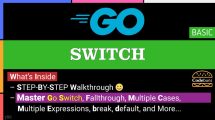| Table of Contents | |
Understanding Go Comments
Go comments are essential for making your code more understandable. You add non-executable lines to your program to explain what your code does. You can describe the purpose of a function, explain a complex algorithm, or add any other relevant information. Using Go comments improves the readability of your code. Other developers, including your future self, will appreciate well-commented code. Golang comments play a crucial role in collaborative software development.
List of Different Types of Comments
Single-line Comments
Single-line comments in Go start with //. Anything after // on the same line is considered a comment. These are useful for short explanations or notes. You often use them to clarify the purpose of a single line of code. Keep single-line comments concise and to the point.
Syntax
// This is a single-line comment
Explanation
//denotes the start of comment.- Everything after
//to the end of the line is ignored. - Used for brief explanations.
Example
package main
import "fmt"
func main() {
// Declare a variable
var x = 10
fmt.Println(x) // Print the value of x
}
Explanation
// Declare a variabledescribes the next line.var x = 10initializes an integer.fmt.Println(x)prints and// Print...comments.
Output
10
Multi-line Comments
Multi-line comments, also known as block comments, start with /* and end with */. Everything between these delimiters is treated as a comment, even if it spans multiple lines. This type of comment is useful for longer explanations. You can use them to comment out blocks of code temporarily.
Syntax
/*
This is a
multi-line comment.
It can span multiple lines.
*/
Explanation
/*indicates beginning of comment block.*/indicates end of the comment block.- Everything between is ignored by compiler.
Example
package main
import "fmt"
func main() {
/*
This is a multi-line comment.
We are calculating the sum of two numbers.
*/
var a = 5
var b = 7
fmt.Println(a + b)
}Explanation
/* ... */contains a multi-line comment.var a = 5andvar b = 7declare variables.fmt.Println(a + b)calculates and prints.
Output
12
Documentation Comments
Documentation comments in Go are a special type of comment used to generate code documentation. They are typically written as multi-line comments, using /* ... */. You can run command, go doc against your code to parse to create HTML documentation. These comments help other developers when they call your function in their programs.
Syntax
/*
FunctionName does something.
It takes an argument 'arg' of type 'type'.
It returns a value of type 'returnType'.
*/
func FunctionName(arg type) returnType {
// ...
}Explanation
- Starts with
/*and ends with*/. - Describes function, arguments, and return type.
- Used by
go docto generate documentation.
Example
package main
import "fmt"
/*
CalculateSum calculates the sum of two integers.
It takes two integer arguments, a and b.
It returns their sum as an integer.
*/
func CalculateSum(a int, b int) int {
return a + b
}
func main() {
result := CalculateSum(3, 4)
fmt.Println(result)
}Explanation
/* ... */documents theCalculateSumfunction.func CalculateSum(a int, b int) intdefinition.return a + breturns the sum.- Inside
func main() {,result := CalculateSum(3, 4)calls. fmt.Println(result)prints the sum.
Output
7
Best Practices for Using Comments in Go
Write comments that explain why your code does something, not just what it does.
- Use comments judiciously: Don’t over-comment your code. Comments should add value and clarify complex logic, not simply restate what the code already does.
- Keep comments concise and to the point: Avoid lengthy, rambling comments.
- Use comments to explain the “why” behind the code: Explain the reasoning behind design decisions, non-obvious algorithms, or edge cases.
- Update comments as you modify your code: Ensure that comments always reflect the current state of the code.
By effectively using comments, you can significantly improve the readability and maintainability of your Golang code, making it easier for yourself and others to understand and work with.
Conclusion
Go comments are an important aspect of writing clean, maintainable code. Using both single-line and multi-line comments helps you improve clarity. Commenting takes little time, but it will save others’ time. Start practicing good commenting habits today.

